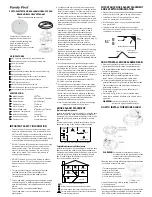
www.directed.com
18
finding a (+) brake light wire
Most vehicles use a (+) brake light circuit. The (+) brake light wire is often found near
the brake pedal.
How to find a (+) brake light flash wire with your multimeter:
1.
Set to DCV or DC voltage (12V or 20V is fine).
2.
Attach the (-) probe of the meter to chassis ground.
3.
Probe the wire you suspect of being the brake light wire.
4.
Press the brake pedal. If your meter shows (+)12V, release the pedal and make
sure it goes back to zero.
5.
If it does return to zero, this is the correct brake wire.
finding the accessory/heater wire
An accessory/heater wire will show +12V when the key is in the accessory and run
positions. It will not show +12V during the cranking cycle. There will often be more
than one accessory wire in the ignition harness. The correct accessory wire will power
the vehicle's climate control system. Some vehicles may have separate wires for the
blower motor and the air conditioning compressor. In such cases, it will be necessary
to add a relay to power the second accessory wire.
finding the rpm input wire
To test for a tachometer wire, a multimeter capable of testing AC voltage must be used.
The tachometer wire will show between 1V and 6V AC. In multi-coil ignition systems,
the system can learn individual coil wires. Individual coil wires in a multi-coil ignition
system will register lower amounts of AC voltage. Also, if necessary, the system can
use a fuel injector control wire for engine speed sensing. Common locations for a
tachometer wire are the ignition coil itself, the back of the gauges, engine computers,
and automatic transmission computers.
















































